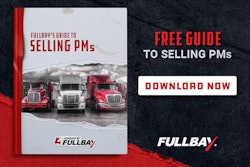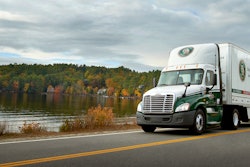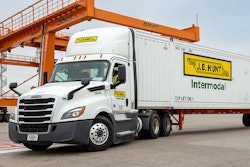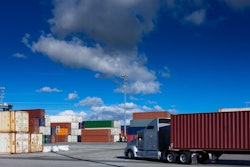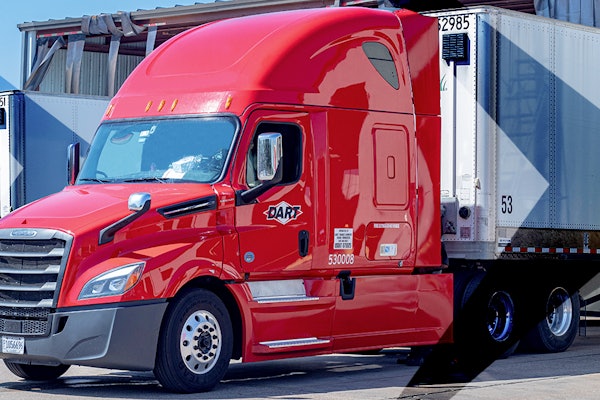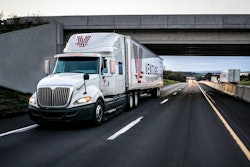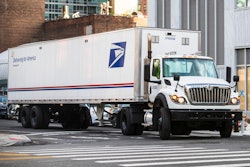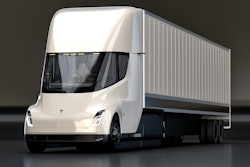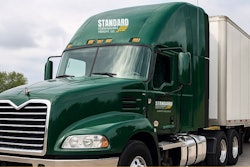The first quarter of 2025 was a tough road for many carriers that faced headwinds ranging from delivery delays and network inefficiencies to rising insurance costs and uncertainties associated with U.S. trade and tariff policies.
While a few fleets managed to improve profitability or find opportunity through acquisitions and cost-cutting efforts, the broader industry continued to grapple with sluggish demand, inflationary pressures, and cautious customer behavior.
Covenant feels impact of extreme weather and avian influenza
Covenant (CCJ Top 250, No. 36) saw its revenue was down 3.4%, while net income was up 72% from a year ago, which the company chalked up due to operational disruptions. Severe winter conditions disrupted operations, affecting utilization and delivery schedules. In addition, the outbreak of avian influenza significantly reduced poultry freight volumes, impacting both the dedicated and expedited segments. Despite a larger tractor fleet, these challenges led to lower equipment utilization, especially in the dedicated segment (down 12.5%).
The average of age of its tractors slightly decreased to 20 months compared to 21 months a year ago, which CEO David Parker said supports operational efficiency and helps reduce maintenance costs.
Revenue: 2025 Q1: $269.4 million vs. 2024 Q1: 278.7 million
Income: 2025 Q1: $6.6 million vs. 2024 Q1: 3.97 million
-
Forward Air reflects operational improvements
Forward Air (No. 31) reported a revenue increase of 13.2% and a smaller net loss (31.1%) from a year ago. CEO Sean Stewart said the company began taking corrective pricing actions for the expedited freight segment that began late last year till February. “We’re pleased to share that in the back half of the quarter, we began to see improvement that we’re anticipating,” he said.
Though the company didn’t see significant pull forward, CEO Sean Stewart noted there was an uptick in the last two weeks of March. “It’s unclear if this was due to pull forward or seasonal projects,” he said.
Revenue: 2025 Q1: $613 million vs. 2024 Q1: $542 million
Income: 2025 Q1: $(61.2) million vs. 2024 Q1: $(88.8) million
-
Heartland Express face declining revenues, profitability pressures
Heartland Express (No. 25) saw revenue decline by 18.8% and a net loss of $13.9 million, slightly improving from a $15.1 million loss a year ago. Operating ratio worsened to 106.8%, signaling higher operating costs relative to revenue. CEO Mike Gerdin attributed challenges to extreme winter weather and tariff uncertainties amongst customers, along with “prolonged industry-wide challenges were operating cost inflation continued to outpace customer freight demand and freight rate improvements.”
Gerdin also added that while the Heartland Express brand remained profitable, other brands like Millis Transfer, Smith Transport, and CFI faced underutilized and driver retention issues, leading to losses.
As of March 31, 2025, the average age of the company’s tractor fleet was 2.6 years, compared to 2.4 years during the same period last year. The average age of its trailer fleet was 7.4 years, compared to 6.7 years on the same period last year.
Revenue: 2025 Q1: $219 million vs. 2024 Q1: $270 million
Income: 2025 Q1: $(13.8) million vs. 2024 Q1: $(15) million
-
J.B. Hunt sees revenue decline across most segments
J.B. Hunt (No. 3) saw a modest revenue decline, driven by weaker performance across several segments. Its dedicated contract services saw a 5% reduction in average truck count, while final mile services saw a 15% drop in stops, integrated capacity solutions saw 15% decrease in load volumes, and truckload saw an 8% decline, all compared to the prior-year period.
These negative trends were partially offset by a 5% increase in intermodal operations, largely driven by an 8% rise in load volume, marked as the highest first-quarter volume in J.B. Hunt’s history. Spencer Frazier, EVP of sales and marketing at J.B. Hunt said on earnings call that the uncertain environment and trade policy has caused unease with customers, with some prolonging contracts and taking a wait-and-see approach.
Revenue: 2025 Q1: $2.92 billion vs. 2024 Q1: $2.94 billion
Income: 2025 Q1: $117.7 million vs. 2024 Q1: $127.5 million
-
Knight-Swift sees profit in U.S. Xpress business
Knight-Swift Holdings (No.4) CEO Adam Miller said after a solid start in the year, conditions grew more challenging, exacerbated by weather disruptions in January and February that “gave way to a tariff drag n March activity that dampened the typical seasonal bid in freight volumes.”
The fluid tariff policy has built a cautious outlook from customers, with some delaying decisions, while others pull forward inventory out of “an abundance of caution,” and a few taking a wait-and-see approach. Knight-Swift’s approach is focusing on factors that are less volatile, Miller explained, including tightening their equipment profile by disposing of underutilized assets, improving safety performance, and reducing overhead to be cost efficient.
In its truckload segment, modest increases in contract rates have remained steady in the bid activity so far, Miller said. Despite tough conditions, the U.S. Xpress truckload business also achieved its first quarterly operating profit since its acquisition in July 2023. Meanwhile, its LTL segment was impacted on volumes and costs from weather conditions in the Southeast where its LTL network density was at its highest.
Revenue: 2025 Q1: $1.824 billion vs. 2024 Q1: $1.822 billion
Income: 2025 Q1: $30 million vs. 2024 Q1: $(2.9) million
-
Landstar combats impact of insurance costs, fraud and cargo theft
Landstar System (No. 10) reported its Q1 earnings after a delay caused by a fraud issue that impacted its freight forwarding operations in late March, with investigations, remediation and collection efforts continuing. President and CEO Frank Lonegro said in earnings call they saw high insurance and claim costs attributed to cargo theft, carrier imposter scams and an upsurge of trucking accidents, with insurance and claim costs up 5.8% compared to the previous quarter. Lonegro said they plan to invest in technology solutions.
Lonegro said the company was “encouraged by the number of loads hauled via truck in the quarter,” as it marked the first time in 15 years that the first quarter exceeded the preceding fourth quarter. “Although, it is hard to determine how much of our first quarter load count was related to efforts by shippers to get ahead of tariffs, we certainly saw this as a positive sign to start 2025,” he said.
Revenue: 2025 Q1: $1.153 million vs. 2024 Q1: $1.171 million
Income: 2025 Q1: $29.8 million vs. 2024 Q1: $47 million
-
Marten sees declines across segments and shrinking fleet
As Marten Transport (No. 37) indicate declines across various metrics, with revenue down 10.6% from Q1 2024. Truckload saw its revenue down 6.4%, while dedicated fell 14.8%, and its intermodal segment slumped 24.1%. Its operating ratio rose to 97.4, compared to 95.1 in the same period last year.
Executive Chairman Randolph Marten said operating results were pressured by the “freight market recession’s oversupply and weak demand, and the cumulative impact of inflationary operating costs, freight rate reductions and freight network disruptions.”
As of March 31, 2025, the carrier had a total of 3,040 tractors, compared to 3,406 tractors in Q1 2024. The average age of tractors was 2.0 in Q1 2025, compared to 1.9 in the previous period. Total trailers in March 2025 were 5,331, while in the same period last year, it was 5,619 trailers. The average age of trailers was 5.4 in Q1 2025, compared to 1.6 a year ago.
Revenue: 2025 Q1: $223.2 million vs. 2024 Q1: $249.7 million
Income: 2025 Q1: $4.3 million vs. 2024 Q1: $9.6 million
-
Old Dominion reflects ongoing softness in economy
Old Dominion Freight Line (No. 9) reported total revenue to be down 5.8% and net income fell 12.9%, from the same period last year. The drop in revenue, CEO Marty Freeman said, reflects a 6.3% decline in less-than-truckload tons per day during the quarter, due to a decrease of fewer shipments. While ODFL saw signs of “encouraging demand” during the quarter, Freeman said there’s a continuous uncertainty with the economy and the company aims to focus on controllable factors.
Operating ratio increased to 75.4% as the decrease in revenue had a deleveraging effect on its operating expenses.
Revenue: 2025 Q1: $1.37 billion vs. 2024 Q1: $1.46 billion
Income: 2025 Q1: $254 million vs. 2024 Q1: $292 million
-
Pamt Corp. reports loss
Pamt Corp., formerly P.A.M. Transportation Services (No. 58), reported a net loss of $8.1 million, with total revenues down 14.9% from the same period a year ago. Logistics operations revenue declined by 24.66%, while operating ratio was up to 98% from 93.9%. Empty miles were flat at 9.0% from the same period in 2024, while revenue per mile declined to $2.04 from $2.11 in Q1 2024. Total loads fell to 94,644 from 102,200. Average company trucks declined to 1,667 from 1,895. Average owner-operator trucks increased to 514 from 365.
President and CEO Joe Vitiritto declined to give a statement, marked as the second consecutive quarter without a comment.
Revenue: 2025 Q1: $136.7 million vs. 2024 Q1: $160.9 million
Income: 2025 Q1: $(8.1) million vs. 2024 Q1: $281 million
-
Schneider National reaps benefit from Cowan Systems acquisition
Schneider National (No. 6) reported improved results on its segments year-over-year. President and CEO Mark Rourke said Schneider is implementing an improvement plan focused on optimizing how capital is allocated to growth initiatives, reducing costs across expense categories, and enhancing both the customer freight allocation process and the overall customer experience.
[RELATED: Carriers cut capital spending, shift strategies amid economic, tariff uncertainty]
Truckload revenue increased 14%, due to its acquisition of Cowan Systems and improved revenue per truck per week, partially offset by lower network volumes. Meanwhile, intermodal revenue increased 5%, driven by volume growth and improved revenue per order. Logistics revenue saw a 2% increase, driven by the Cowan acquisitions, but were partially offset by lower brokerage revenue per order and volume.
Revenue: 2025 Q1: $1.4 billion vs. 2024 Q1: $1.3 billion
Income: 2025 Q1: $26.1 million vs. 2024 Q1: $18.5 million
-
Saia sees net income fall
Saia (No. 19) posted a 4.3% revenue increase, while operating income saw a 40.5% decrease, compared to Q1 2024. Operating ratio also increased to 91.1% compared to 84.4%, indicating increased challenges. Saia President and CEO Fritz Holzgrefe attributed the decline in operating income to the uncertain macroeconomic environment and adverse weather events, including extreme winter weather in the southern part of the country that prompted closures and limited operations. Despite headwinds, Saia saw shipment growth of 4.6% for the quarter, led by terminals opened in the past three years.
LTL shipments in Q1 were up 2.9%, driven by revenue per shipment increasing to 1.5%. LTL pounds per shipment were up 7.8%, and LTL revenue per hundredweight decreased 5.8%.
Revenue: 2025 Q1: $787 million vs. 2024 Q1: $754 million
Income: 2025 Q1: $49.8 million vs. 2024 Q1: $90.6 million
-
Werner posts net loss of $10.1 million
Werner (No. 14) saw revenues down 7% and net income down 260%, compared to a year ago. Chairman and CEO Derek Leathers attributed results to elevated insurance costs and claims, extreme weather, a smaller fleet and changes in customer activity from tariff-induced uncertainty. Werner is deliberating on strategies to mitigate the impact of higher prices brought on by tariffs, Leathers said on an earnings call, including delaying new tractor purchases and sales. This is feasible, he said, as Werner’s average tractor age of 2.2 years provides flexibility on equipment purchases and sales or shifting between OEMs to those less affected by tariffs.
Despite setbacks, Werner’s dedicated business won several fleet contracts from new and existing customers, representing over 200 trucks, which will be implemented in late Q2 and Q3. Its one-way truckload segment’s revenue per total mile was up for the third consecutive quarter, despite weather interferences, increased deadhead and network inefficiencies. Logistics segment also improved its operating income and margin, which Leathers, said is thanks to its focus on cost management. It also increased its cost savings target for the year to $40 million from $25 million, with $8 million already achieved in Q1.
Revenue: 2025 Q1: $712.1 million vs. 2024 Q1: $769 million
Income: 2025 Q1: $(10) million vs. 2024 Q1: $6.3 million
-
XPO sees consecutive LTL margin improvement
XPO (No. 7) reported revenue down -3.2% and a net income rise of 3.0%. The year-over-year decrease in revenue was due primarily to lower fuel surcharge revenue in the North American LTL segment, XPO said.
LTL segment performed well with a sequential margin improvement better than typical seasonality and have improved its adjusted operating ratio to 85.9%, outpacing seasonality. CEO Mario Harik said in earnings call that XPO successfully decreased purchase transportation costs by 53% year-over-year and reduced outsourced linehaul miles to just 8.8% total miles.
The company is getting a cautious tone from customers regarding tariff impacts, Harik said. Customers are taking three approaches: a wait and see pattern, pulling forward inventory, and redesigning their supply chain to get more product sourced or built locally.
Revenue: 2025 Q1: $1.95 billion vs. 2024 Q1: $2.02 billion
Income: 2025 Q1: $69 million vs. 2024 Q1: $67 million

